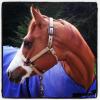How the Dog Got It's Spots...
During fetal development cells called melanocytes migrate out from the spinal cord to other areas of the body. These melanocytes produce the pigment that “colors†the dogs coat and skin. Areas where the melanocytes do not reach during fetal development remain without pigment causing areas of white hair and pink skin. The areas most commonly white in dogs are the last areas that are reached by the melanocytes: the chest, tip of the tail, and the toes. The current theory on white pattern development is that environmental factors in the womb (and perhaps white booster or suppressor genes) can affect melanocytes migration resulting in small white spots in these areas without an actual white pattern mutation. When mutations occur in the genes that control melanocyte migration, large areas of white can result. Recent studies have shown that at least one white pattern is the result of a mutation in the gene microphthalmia-associated transcription factor (MITF). However, this mutation does not account for all the white patterns found in canines and in some dogs the mutation does not follow the expected pattern indicating additional genes at work. (Schmutz et al. 2009)
At this time, it is accepted that there are 3 alleles of the S locus responsible for known white patterns: S (solid), sp (piebald), and si (irish spotting). Sp and si are both considered to be recessive to S. In the past an additional allele sw was theorized but it now appears that the extreme white phenotype that was attributed to this allele is instead the result of dogs being homozygous for sp. The variation in the amount of white found in spsp dogs can be attributed to additional genes that “boost†or “suppress†the white pattern. It also appears that additional white pattern mutations can interact with sp in a co-dominant manner to modify the amount of white expressed. (Schmutz et al. 2009) For the purposes of this article we will assume that such a modification is produced by the interaction of sp and si.
The family of Rat Terriers shown on the left is being used as an example of white pattern inheritance because they exhibit a variety of white. There is a low white dam, a medium white sire, and high white offspring. Because the dam is low white but has produced a high white pup we can assume that she carries the recessive piebald allele. She is therefore, at least for our purpose, Ssp. The sire is what is known as a blanket back. Several genotypes are possible for this phenotype. It is possible that he is spsp with a white pattern suppressor, sisi with a white pattern booster, or spsi (with the alleles for piebald and Irish spotting working together in a co-dominate fashion). Because the Irish spotting pattern is known to occur in Rat Terriers and because he has produced a piebald pup we will assume that he is spsi. None of the pups in this litter have an obvious Irish spotting pattern but this is to be expected as the dam is Ssp and Irish Spotting is recessive to S. With these assumptions it is possible to account for all the phenotypes in this litter.
We have several low white pups which would be Ssp or Ssi. The blanket back pup can be assumed to be spsi like the sire, with the si inherited from the sire and the sp from the dam. The piebald pup is of course spsp with one sp allele inherited from each parent. Of course it’s not possible to know for certain if our assumptions are correct until genetic testing is available but assumptions such as these are reasonably accurate and can help breeders predict the amount of white that will be present in their pups. There is still much about white pattern genes and modifiers that are not understood but the field of color genetics is constantly expanding. The data presented in this article should not be considered final but simply the current understanding of an evolving knowledge base. The Rat Terrier photos in this article are all courtesy of Sunset Acres Rat Terries



So well written, you make it
So well written, you make it very easy to understand here:)